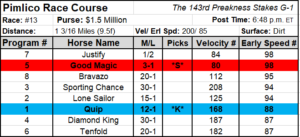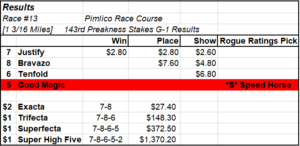…Recap of the Preakness projections and results
By Hal Wafer ׀ RogueHandicapper.com ׀ @RHandicapper
Las Vegas, NV – May 22, 2018 – This past week I gave you two horses that the Rogue Ratings computer program like specifically which was Good Magic (finished 4th) and Quip (finished 8th).
The Preakness Stakes 2018 Rogue Ratings Projections/ Results
 This is a good time to still point out the effectiveness of the Rogue Ratings computer program even though we missed on both Good Magic *S* Speed Horse and or Quip *K* Key Horse as the winner of the 2018 Preakness Stakes. If you follow my analysis of how to correctly read the Rogue Ratings in my articles, which I hope you
This is a good time to still point out the effectiveness of the Rogue Ratings computer program even though we missed on both Good Magic *S* Speed Horse and or Quip *K* Key Horse as the winner of the 2018 Preakness Stakes. If you follow my analysis of how to correctly read the Rogue Ratings in my articles, which I hope you  learn from and enjoy?
learn from and enjoy?
Simplifying Race Shape and Pace from the Rogue Ratings
First, see how the Race Shape/ Early Speed pace numbers are extremely accurate time and time again (the big picture) for showing you how a race looks to develop. As in The Kentucky Oaks, The Kentucky Derby and The Preakness Stakes clearly showed you!
Now, what I’m referring to is understanding that algorithms can only do so much for us as human beings and that the key to unlocking the treasure chest of being a winning handicapper or analyst is deciphering what the Velocity numbers and Early Speed numbers in the Rogue Ratings computer projections (even though most of the time it nails it precisely with the horses it highlights) are showing and educating you about in a horse race.
 Additionally, the Rogue Ratings will only select one *S* Speed Horse (highlighted) for you and that is why it didn’t pick both of these horses. As you will never see two red or three colored horses’ listed as Speed Horses *S* within the Rogue Ratings computer program. But, as you learn to analyze horse racing in a more sophisticated way you will see that it’s very easy to come to the conclusion that both Justify and Bravazo were additional contenders in the race you needed to include in your wagering. Once you start to delve into the Rogue Ratings computer program it will take your handicapping to the next level of understanding.
Additionally, the Rogue Ratings will only select one *S* Speed Horse (highlighted) for you and that is why it didn’t pick both of these horses. As you will never see two red or three colored horses’ listed as Speed Horses *S* within the Rogue Ratings computer program. But, as you learn to analyze horse racing in a more sophisticated way you will see that it’s very easy to come to the conclusion that both Justify and Bravazo were additional contenders in the race you needed to include in your wagering. Once you start to delve into the Rogue Ratings computer program it will take your handicapping to the next level of understanding.
The Preakness Stakes winner Justify was clearly a horse that had a very good Velocity number of 84, which is only a 4-point difference from Good Magic who possessed a Velocity number of 80 in the race. Also, both Justify and Good Magic had matching high Early Speed numbers in the race of 98. Now, go back to The Preakness article in which I outlined the potential Race Shape and how it was projected to be between Justify and Good Magic…this should help show you in just one way how the Rogue Ratings computer program is extremely effective!
Raise Your Turf-Knowledge by Using the Rogue Ratings Velocity Numbers
It’s been said, that the way to tell the class level of a race horse is to see if it has the “look of eagles” or put another way it has an undefinable quality that you can’t measure or put a finger on. Which I say isn’t what true class in a race horse really is. My turf-knowledge says to you, “It’s the ability of a race horse for a short distance to run faster within a small window of the race which results in taking the heart/ will out of it competitor and leaves it as an also-run”.
The Rogue Ratings computer program does this by giving you a quantifiable number (velocity number) to measure a horses motor coming into a race and does so very consistently and effectively better than anything I know of personally.
Remember, the racing form or other information sources that you may use or get is just that, information and nothing more like Egyptian hieroglyphs that needs to be deciphered. As you still need to know what factors to calculate and then how to accurately compute all this information in a timely manner.
As said by The Rogue Handicapper®, “Rogue Ratings computer program is all about taking the complexities out of thoroughbred handicapping and making it straightforward, and winnable”!
Understanding the Dance Between the Velocity and Early Speed Numbers
To take your knowledge to the next level with the Rogue Ratings computer program which my mentored clients have done and their results speak for themselves.
The key to seeing things with a clear lens is to balance the Velocity number and the Early Speed number a horse produces (like a scale) and comparing those numbers to the rest of the field and how the race shape looks to develop. This will clearly point out where that horse stands in relation to the whole field by measuring its motor and who looks to be in a more advantageous position because of pace/ race shape versus others that maybe at a disadvantage.
When the Light-Bulb Goes On
The more you use the Rogue Ratings computer projections the better you will see how easier it will become to analyzing a horse race as the sophisticated computer program does most of the heavy-lifting (more accurate measurement) or a horse and clearly lays out the race shape for you.
As you better see the consistency of the Rogue Ratings computer projections finish consistently first, second and third, and the watch the prices they pay…that’s when the light-bulb should go on!
Rogue Handicapper Bio
 Hal Wafer aka The Rogue Handicapper® created his website (RogueHandicapper.com) as a tool for new fans, novice and seasoned handicappers, tournament players and sophisticated gamblers on “How to Gain” an invaluable edge against their competition in the contest room (mentoring) or at the track and Cash More Tickets!
Hal Wafer aka The Rogue Handicapper® created his website (RogueHandicapper.com) as a tool for new fans, novice and seasoned handicappers, tournament players and sophisticated gamblers on “How to Gain” an invaluable edge against their competition in the contest room (mentoring) or at the track and Cash More Tickets!
My background includes race & sports book operations, live pari-mutuel operations, hub operations, ADW operations, marketing,
player development, simulcasting, first sponsored tournament player by an ADW (BetAmerica.com), NTRA/ NHC player committee member (since 2011) and mentor (since 2017).
Also, I wrote one of the first books on handicapping contests titled “A Survey of Track Handicapping Contests-Rules-Suggestions-Potential” which was published in 1999 by Harness Tracks of America (by Stanley Bergstein) and was used as a guide by The Daily Racing Form and the NTRA for helping to create their National Handicapping Championship Tour.










Speak Your Mind